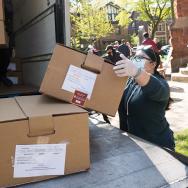The University of Chicago Medicine’s no-questions-asked, self-serve Feed1st pantry program more than doubled its distribution rates between March 2020 and November 2021 compared to the previous year, providing more than 42,000 pounds of food (a 124% increase) to patients, hospital visitors and staff during the pandemic. This contrasts with a comparable program that required ID or other restrictions, which saw a decline in participation during the same time.
These results were published in the American Journal of Public Health, and according to the research team, demonstrate the importance of open access food pantry programs.
“We compared our impact to the impact of another urban hospital, serving a similar population, with food pantries that had barriers to access, such as requiring an ID or a provider referral and waiting for a pantry staff member to bring them food,” said Cristianne Frazier, who manages the Feed1st program. “We saw a substantial increase in our distribution rates during the pandemic, while the questions-asked hospital program actually saw a decrease — they served fewer people and distributed less food during the pandemic compared to before it.
“The ‘feed first’ model maximizes dignity and facilitates use by requiring no permission and no documentation to access, which we believe increases the likelihood that individuals who need food will help themselves to this resource,” she continued.
Currently, federal and state policies limit the implementation of this type of pantry model; the USDA and state agencies usually require food pantry programs to gather information from patrons to distribute government-sourced food. Frazier hopes that these results help encourage policy changes that will enable more food pantries to take an open access approach.
“Our hypothesis is that widespread implementation of open access food pantries, especially in communities that have been socioeconomically marginalized, would have a bigger positive impact on public health than the traditional models,” said Frazier. “Feed1st has been running for more than 10 years thanks to the hospital’s community benefit program, partnerships and generous donors, but others trying to start up similar pantries around Chicago have run into barriers with obtaining food due to these policies.”
The research team argues that questions-asked pantry models create structural barriers that prevent many in need from accessing food pantry resources, and the questions asked by many food pantries only serve to highlight the issue. “On one intake form required by Illinois Department of Human Services, you have to attest that your income is below a certain value and acknowledge that there may be legal consequences for you if you misuse the food,” said Frazier. “Food insecurity is a dynamic state, and people may be reluctant to identify as being in need, let alone sign such a document.”
Beyond the value of simply feeding those who are hungry, addressing food insecurity can also lead to improvements in health. “Among children, food insecurity is associated with developmental delays, hospitalization and emergency department use. Among adults, it’s linked to things like depression, anxiety, diabetes and hypertension,” said Frazier. “Food insecurity affects health, which can in turn affect healthcare costs.”
No decrease in cafeteria sales
By removing as many barriers as possible, the Feed1st program hopes to reduce stigma and increase accessibility. In fact, during the pandemic, Feed1st program saw such an increase in use that the group opened several new pantries around the hospital, including a first-of-its-kind pantry located within a hospital cafeteria.
The researchers reported that despite the pantry’s proximity to a food retail location, the cafeteria saw no negative impact on sales.
“A cafeteria is arguably the least stigmatizing and most obvious place to find food if you need it,” said Frazier. “We’ve been operating in the cafeteria for over two years. The fact that the retailer saw no decrease in sales suggests that this model could scale to other food retail sites, outside of our hospital, providing further support for our community.”
The research team says their next goal is to find a way to measure the impact of the program, beyond just the amount of food distributed and voluntary sign-ins from pantry patrons. Without the ability to expand the model within the community, where it could be used to assess the effects on food insecurity at a population level, the research team is facing the challenge of studying individual impacts without compromising the model, which does not require demographic or other information from patrons.
As the Feed1st team works on expanding their reach, with other hospitals replicating their approach, the researchers are eager for more data that can help shift policies to support the open access model and allow for expanded partnerships with the food depositories that distribute food to the pantries.
“It’s not surprising to me that when you stop asking people questions and just let them help themselves, you’re going to distribute more food,” said Frazier.
Feed1st founder Stacy Tessler Lindau added, "Food that is freely available to the community cannot be stolen. Our pantries invite people to take as much as they need for themselves and anyone they know in need. This way, pantry patrons include both receivers and givers, a feature of the program that promotes dignity and sustainability."
Additional study authors include El A. Pinkerton, Mellissa Grana, Meryl Davis, Spencer Asay and Jennifer A. Makelarski of UChicago Medicine.
Citation: “Feed1st, No Questions Asked: How a Hospital-Based Food Pantry Program Grew Its Impact During the COVID-19 Pandemic.” Frazier et al, American Journal of Public Health, Aug. 25, 2022.
Funding: National Institute on Minority Health and Health Disparities, the Ralph Lauren Corporate Foundation, and the American Family Insurance Dreams Foundation.
–Adapted from an article published by the University of Chicago Medicine.

